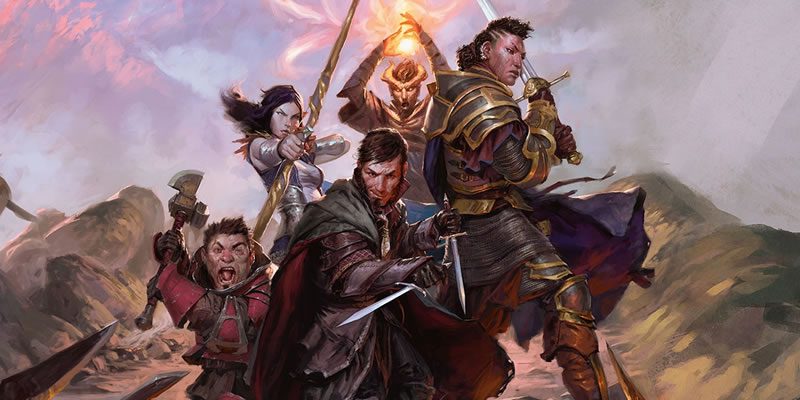UA: Class Feature Variants Breakdown, Part One

I don’t want to alarm you, but this week’s UA is absolutely huge in both its actual volume (13 pages) and its impact (it touches every class in the Player’s Handbook to one degree or another). The article title suggests that it’ll be mostly replacing features (“variants”), but in actuality it’s mostly direct enhancements to features. These are almost universally quality-of-life improvements and efforts to solve for what the designers have learned about their game in ongoing development.
It’s definitely possible to go too far with this kind of thing and get into massive power creep. I’m not really seeing that here, though: instead, it’s keeping the Player’s Handbook classes and some of its subclasses from falling behind. If you wanted to think of this as some metagame housekeeping, that would be fair – as long as you recognize that as a non-pejorative phrase. Remember, they’ve had five years of this edition with incredibly minimal errata. All of these changes are at the DM’s option, formally.
At Shawn’s request, I’m cutting this article into two parts.
Barbarian – Monk | Paladin – Wizard
Proficiency Versatility
Do you want to change up your skill proficiencies? When you pick up an ASI, you can also change one skill choice, even if that means dumping one of your background or subclass-feature-granted skills. You have to switch to a class skill of your 1st-level class.
This is fine, but personally I favor allowing this respend on any level-up. One of the big shifts in my game-running thought over the last couple of decades is that being stingy with tweaking builds just means your players are spending more time with buyer’s remorse. Why would you even bother with that?
Barbarian
Survival Instincts replaces Danger Sense (though Danger Sense is good and you should think carefully about choosing this). It grants two more skill proficiencies from a list of five (Animal Handling, Medicine, Nature, Perception, or Survival), and expertise in those two skills. That’s still a tiny bit awkward with 1st-level vs 2nd-level skill picks, but I wouldn’t make a huge thing about it.
I love how this supports barbarians as something other than meatheads – they can plausibly be the party’s go-to person for two skills, even with a marginal Int or Wis. This blurs the barbarian/ranger line in a way that I see as very good.
To be honest, though, I wish this were offering Fighting Styles to barbarians. While I’m asking for the moon and stars, I’d like some features tweaked to be Dex/TWF-friendly.
Since I’m definitely not the very first-to-press with this, I have the luxury of reacting a bit to some of the other commentary I’ve read. I think Jared Rascher makes some good points about this in his breakdown – like I have often done, he objects to the proliferation of expertise that blows the curve on skill values. It does do that, but I’m so used to barbarians and fighters being so bad at every skill application that isn’t Athletics that I feel uncommonly charitable here. If it got pruned back to extra proficiencies… I’d just ask why they changed this and not the proficiencies the class initially grants. Handing out skills in a feature does very weird things once multiclassing comes onto the scene.
Instinctive Pounce replaces Fast Movement, and lets you spend your reaction to move up to half your speed without provoking opportunity attacks when a creature moves to within 15 feet of you. It’s more net movement in the moment, and the non-provoking part gives the sense that it’s a mighty leap. Classic barbarian/berserker stuff, though hanging it on a reaction means it’s not great for 14th-level and higher Berserkers.
Bard
Spellcasting: The document adds 23 more spells to the bard spell list. No tradeoff – here are some more spells that do fit the bardic magic theme. I can’t find anything to object to here.
Magical Inspiration covers the fact that Bardic Inspiration dice can’t add to spell damage or spell healing, so the bard is a lot less useful to primary spellcasters. Your die applies to “one damage or healing roll of the spell,” which is (as far as I understand it) an incredibly dangerous phrasing in 5e. See, technically, magic missile is one die roll that applies to every missile. With this, each missile deals 1d4 + 1dX (Bardic Inspiration die) + 1, and it scales smoothly with upcasting. It’s also highly beneficial to mass healing word.
Those are probably two of the most significant use cases, but I think those are getting through as an acceptable cost of doing business if it makes bards highly-valued members of caster-heavy teams.
Spell Versatility lets bards cycle out one Spell Known at the end of any long rest, as long as the new spell is the same level as the old one. This is probably okay – see what I said before about not sweating respend mechanics. In fairness to those who have objected to this feature, it’s a massive breach with sorcerer theme, and to a much lesser extent bard and warlock theme. I can’t help but notice that Eldritch Knights and Arcane Tricksters don’t get a similar leeway.
Cleric
Cantrip Versatility lets clerics cycle out cantrips whenever they gain a level. Sure, no problem.
Spellcasting: The cleric list gains nine spells. Some used to be paladin exclusives – a bunch of smites, the aura spells (vitality, life, purity), and power word heal (for no evident reason, this has been bard-only up to now). I kind of liked smites being paladin exclusives, but they had backed off that enough in various subclasses that dropping the act and letting clerics cast them is fine by me. Once you go that far, though, there’s zero reason not to let Eldritch Knights, Valor bards, and Bladesingers in on the act. Maybe that’ll show up if/when this document hits official status.
Channel Divinity: Harness Divine Power gives clerics a lesser version of Arcane Recovery: they can burn a CD to regain a 1st-level slot as a bonus action. Considering that clerics regain CDs on short rests just like warlocks regain Pact Magic, though, this is a big deal – it’s a lot of free bless or cure wounds spells. It also cuts into the wizard’s advantage in spell slots per day. All told, though, I don’t think I object.
Blessed Strikes does That Thing I’ve Been Saying Forever: there’s no reason at all to give some domains Divine Strike and others Potent Spellcasting. This unites those features into a 1d8 radiant bonus. They left out the 2d8 at 14th level. I find that weird, but it’s that way on purpose. It loses the thematic energy types that each Divine Strike domain previously offered, but that could get wedged back in.
Druid
Cantrip Versatility does the same thing here for druids.
Spellcasting: Druids gain 21 new spells. My opinion on each individual addition ranges from “yes good” to “finally, omg” (ceremony, augury, and revivify, I’m looking at you). Zero complaints; considerable improvement for damage-focused druids.
Wild Companion gives you a different way to spend you Wild Shapes – on a find familiar spell without material components. So now your druids can all have an owl to grant one person advantage on their first attack each round. If you’ve been wishing you could play a 3.x-style druid with a beast companion… this still won’t do it, because it’s not a combat familiar, but it’s a great move for scouting if you don’t want to take the risk yourself. Owl-snark aside, this is fine. (Flyby Attack is just better than literally every other baseline familiar feature.)
Fighter
Fighting Style Options opens up one new fighter-only fighting style, as well as pointing out that there are a lot more new fighting styles at the end of the document. Superior Technique gives you one Battle Master Maneuver and 1d6 CS die. It’s not clear if this automatically becomes 1d8 if you take the Battle Master subclass, though it does absolutely become 1d10 at level 10, because of how the Battle Master 10th level feature is phrased. Getting to be a Champion or Cavalier or whatever while still dipping your toe in the fun of Maneuvers (and ideally picking up Martial Adept along the way) sounds like great fun to me.
Maneuver Versatility lets you respend Maneuvers as part of any long rest. I am super duper here for Maneuvers as your morning katas – that is, your fighter “spell prep.”
Maneuver Options drops seven new Maneuvers on us, which… is it Christmas? It might be Christmas.
- Ambush lets you apply your CS die to Dex (Stealth) or initiative rolls.
- Bait and Switch is very pure warlord/tanking goodness – castling with an ally and adding the CS die to your ally’s AC until the start of your next turn. Very happy about this one – if I ever get to play my Battle Master again, this is a top priority.
- Brace is referencing setting a spear to receive a charge, but it applies to any weapon. This is some brutal tanking stickiness and I am all about it.
- Restraining Strike adds a grapple to your attack, adds the die value to your Str (Athletics) check, and the target is restrained until the grapple ends. Uh, wow? I wrote something similar a while back, but this is bolder on power level than I was – so I actually feel great about that. https://www.tribality.com/2018/10/17/battle-master-maneuvers-for-grappling/
- Silver Tongue lets you add your CS die to one Cha (Persuasion) or Cha (Deception) check. This is about playing a fighter who can do more than just stab – a debonair swashbuckler. YES.
- Snipe lets you make an extra ranged weapon attack as a bonus action, and add the CS die to the damage. You can draw a thrown weapon as part of this attack. The fun of taking extra bow shots or hucking handaxes as part of your combat routine should be obvious, though Snipe seems like not quite the right name to me? Anyway, incredibly strong purchase.
- Studious Eye lets you add your CS die to a Wisdom (Insight) or Int (Investigation). It’s again about supporting more breadth of fighter concepts – in this case a two-fisted shamus.
So yeah. You could say that I’m a fan. Battle Master has been my favorite flavor of fighter since its D&D Next drafts. Now it’s not only one of the most engaging playstyles, it’s also supporting more character concepts than anything else.
I think it also makes the most sense to cover the other new Fighting Styles here.
Fighting Styles
Martial Versatility lets fighters, paladins, and rangers change fighting styles whenever they gain a level. This recently came up in my campaign, as the low-level axe-and-shield paladin (Dueling style) received an ludicrously overpowered greatsword from some of the higher-level PCs, and – being no one’s fool – respent to Great Weapon style at the first opportunity. Again, make respending easy. Buyer’s remorse is not an element of the supporting fiction or anyone’s fun.
There are four new styles:
- Blind Fighting means you don’t have disadvantage to attack targets you can’t see, as long as they aren’t hidden from you. The can’t see/hidden thing (because an invisible target isn’t necessarily hidden) is a weird aspect of D&D’s stealth and perception rules, so don’t even go down this road unless you grasp the subtleties. Blind Samurai now have clear mechanical support, though!
- Interception… hey, if you’ve been reading my work for any length of time, you probably know how I feel about the Protection fighting style. This? This is the fix. Don’t buy Protection. Interception is the real deal.
- Thrown Weapon Fighting answers the long-standing complaint that you can’t play a javelin-hurler or handaxe-chucker. This lets you draw a thrown weapon as part of the attack any number of times per round, rather than just once, and grants a +1 bonus to your damage rolls. It’s not a concept I’m dying to play, aside from a boulder-throwing goliath, but it’s exactly what it should be.
- Unarmed Fighting gives you a base d6 unarmed damage die, or d8 if you do the Kirk double-fisted thing. Further, your grapples are inherently damaging (just a d4, but hey), and adds that d4 to attacks you make against a target you grapple. I’m on the record as a diehard fan of the 4e Brawler fighter, and this is the real deal for that. It doesn’t need to be its own subclass now – just a fighting style that can mesh with the Battle Master. YES.
Yep, these are all where I think they should be. Four solid hits.
Monk
Monk Weapons lets you define your own class of monk weapons, choosing up to 5 + Wisdom modifier weapons. “Must be a simple or martial weapon” rules out improvised weapons. “You must be proficient” is a weird qualification to include, since… you’re a monk, stuck with monk weapon proficiencies?… but I think the goal is to create a much more interesting set of possibilities for weapon proficiencies derived from racial features. The weapon can’t be Heavy, Special, or Two-Handed, which frustrates me inasmuch as it means a glaive-wielding sohei isn’t based off a monk, and there are no tetsubos or ōdachis among monks. It’s not horrible, it’s just weird to see what things remain strict boundaries.
Ki-Fueled Strike lets you make one unarmed attack as a bonus action whenever you spend ki in your action. This is a gift to the Way of the Four Elements monks, who now get to punch something as well as fireballing it. (But the Way of the Four Elements is generally understood to be underpowered, so this is fine.)
Ki Features grants two new ways to spend ki at 2nd level.
- Distant Eye lets you ignore disadvantage for attacking at long range, in exchange for 1 ki point. This is worthwhile for Kensei, I guess?
- Quickened Healing is a fairly expensive self-heal for all monks: 2 ki points for healing equal to the result of your Martial Arts die.
- That’s… pretty much overwriting the value of Wholeness of Body. WoB heals 3 * monk level, 1/long rest. Quickened Healing is expensive in mid-combat, but the ability to use it several times a day (and more if you can take a short rest) is incredible. I would like to see this cut way back in power, though I’d be even happier with toning this down only slightly, and beefing up Wholeness of Body a bit. (F’rex, let Wholeness heal other people. If Mr. Miyagi can do it, it’s a well-supported element in the supporting fiction.)
Conclusion
That brings me to the end of Part One of this breakdown, from the beginning of the article to the end of the monk. Part Two, beginning with the paladin and going to the end of the article, has the real hot commodity: the All-New, Somewhat-Different Revised Ranger! It also has some very slick warlock content that I’m excited to cover.
Overall, I am a huge fan of this content. There are a couple of odd choices and, arguably, some pain points. The fighter content is the gift that keeps on giving. Spell Versatility is going to have a significant impact on the metagame in this form, but if I have to choose between that and a player who’s going to be steadily unhappy at least until the next time they level, maybe longer – I’m all about this. Finally, I like where their thinking is on barbarians, but I’m looking for deeper structural work than that.



